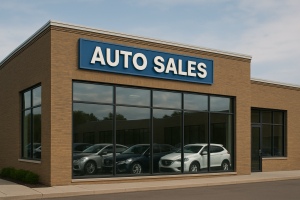Why Glass Window Retrofits Make Sense for Auto Dealerships
 Auto dealerships and service centers nationwide face a growing challenge: maintaining comfortable indoor environments without increasing energy costs. With rising utility rates and aging buildings, the strain on heating and cooling systems is becoming harder to ignore. Whether it’s a sunlit showroom filled with new vehicles or a busy repair bay with constant door traffic, controlling indoor temperatures is critical—not just for comfort, but also for efficiency, staff productivity, and long-term sustainability.
Auto dealerships and service centers nationwide face a growing challenge: maintaining comfortable indoor environments without increasing energy costs. With rising utility rates and aging buildings, the strain on heating and cooling systems is becoming harder to ignore. Whether it’s a sunlit showroom filled with new vehicles or a busy repair bay with constant door traffic, controlling indoor temperatures is critical—not just for comfort, but also for efficiency, staff productivity, and long-term sustainability.
One solution receiving serious attention is commercial retrofitting — specifically with vacuum-insulated glass (VIG) and other advanced glazing technologies. These upgrades help auto businesses improve thermal performance without replacing entire window systems. For spaces with extensive glass or inadequate insulation, such as showrooms and service bays, this approach provides a cost-effective path to improved energy efficiency and a more consistent indoor climate.
Why Climate Control Is So Challenging in Auto Facilities
Most auto dealerships and repair centers were constructed before modern energy efficiency standards became widely adopted. The original windows—often single-pane or older double-pane units—weren’t designed to handle the extremes of today’s weather or the demands of modern HVAC systems.
In showrooms, large glass panels are used for good reason: they let in natural light, create a visually open environment, and showcase vehicles to passing traffic. But all that glass acts like a greenhouse. In summer, sunlight pours in and overheats the space. In winter, that same glass becomes a weak point, allowing warm air to leak and letting cold drafts inside.
Service bays bring their own issues. Large roll-up doors open and close throughout the day, making it challenging to maintain a stable temperature. These areas often have high ceilings, limited insulation, and older windows that do little to help. As a result, HVAC systems in these spaces run constantly, driving up energy use and costs—often with limited success.
How Window Retrofitting Works
Window retrofitting doesn’t require tearing out entire frames or doing major structural work. Instead, it involves upgrading specific components—typically the glass itself—to improve energy performance.
Vacuum-insulated glass (VIG) is one of the most advanced options on the market. It has two panes of glass separated by a vacuum layer, which drastically reduces heat transfer. Compared to standard double glazing, VIG is much thinner and lighter, making it easier to install in existing window frames without structural changes.
What makes VIG ideal for dealerships and service centers is its combination of performance and practicality. It provides insulation levels that rival those of triple-pane glass, but without the added bulk or weight. This means it can preserve the appearance of large, clear showroom windows while still delivering big improvements in thermal performance.
Retrofitted windows help regulate indoor temperatures, reduce the load on HVAC systems, and lower energy bills—all without sacrificing natural light or aesthetics.
Real-World Benefits: A Midwest Case Study
These benefits aren’t just theoretical. One Midwest chain of automotive service centers recently upgraded the windows in their garages and showrooms using VIG retrofits. Within the first year, they observed a measurable decrease in energy use, particularly during the hottest and coldest months. The HVAC systems didn’t have to work as hard to maintain comfortable conditions, which also reduced maintenance needs and extended equipment life.
Employees noticed the difference, too. Mechanics working near exterior walls reported fewer cold drafts in winter, and sales staff noted that the showroom stayed cooler in summer without the need for constant thermostat adjustments or the use of fans. These improvements helped boost morale and reduced complaints about indoor comfort—a small but important factor in daily operations.
Retrofitting vs. Full Replacement
One reason retrofitting is gaining popularity is its cost advantage. Full window replacement in a commercial building is expensive, often requiring custom framing, structural work, permits, and potentially days or weeks of business disruption.
Retrofitting, by comparison, can often be completed more quickly and with far less interruption. Most VIG units are designed to fit into existing frames, minimizing labor and material costs. And because you’re not overhauling the building envelope, retrofitting avoids the visual and architectural compromises that sometimes come with full replacements.
Retrofitted VIG units can also include low-emissivity (low-E) coatings or UV protection to enhance energy performance further and protect vehicle interiors from sun damage—another important consideration in glass-heavy showrooms.
Long-Term Value for Dealership Owners
While the upfront cost of VIG retrofitting is higher than basic double-pane glass, the long-term return on investment is strong. Lower energy bills, fewer HVAC repairs, and improved occupant comfort all add up over time.
There’s also a reputational and competitive benefit. Today’s customers and employees care about sustainability and workplace quality. A dealership that invests in energy-efficient upgrades signals that it values environmental responsibility and modern building standards—both of which can influence customer perception and employee retention.
In many areas, utility companies and local governments offer rebates or tax incentives for energy-efficiency upgrades, which can further reduce the payback period for retrofitting projects.
A Smart Upgrade for the Road Ahead
Auto dealerships and service centers aren’t going to get less complex or cheaper to run. As energy prices fluctuate and weather becomes more unpredictable, building performance will matter more than ever.
For business owners seeking to enhance comfort, reduce costs, and prolong the lifespan of their facilities, window retrofitting with high-performance glazing, such as VIG, is a smart and practical step. It doesn’t require major renovation, but it delivers major impact.
In a competitive market, making your space more efficient and more comfortable—without sacrificing the visibility and style that drive sales—could be one of the best investments you make.
